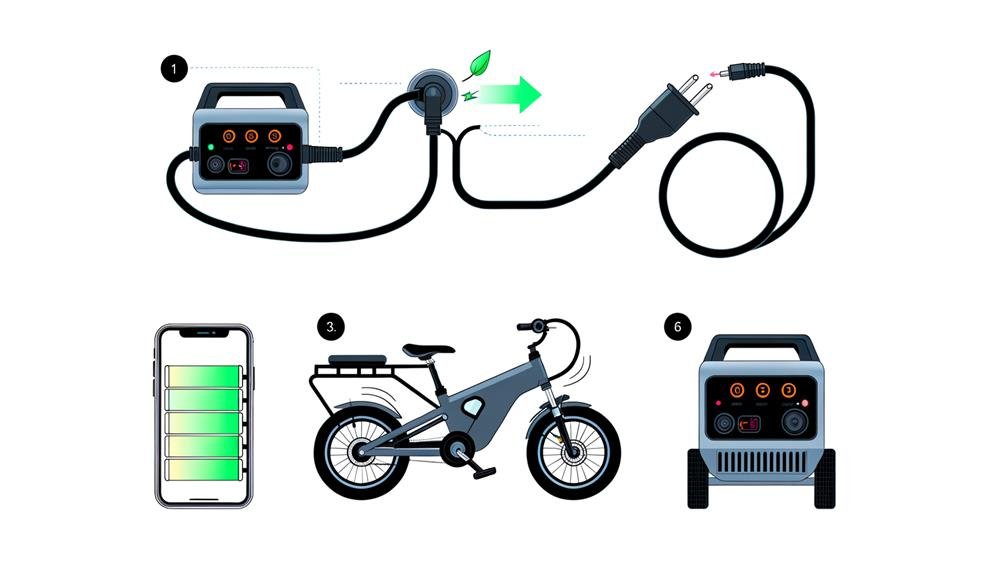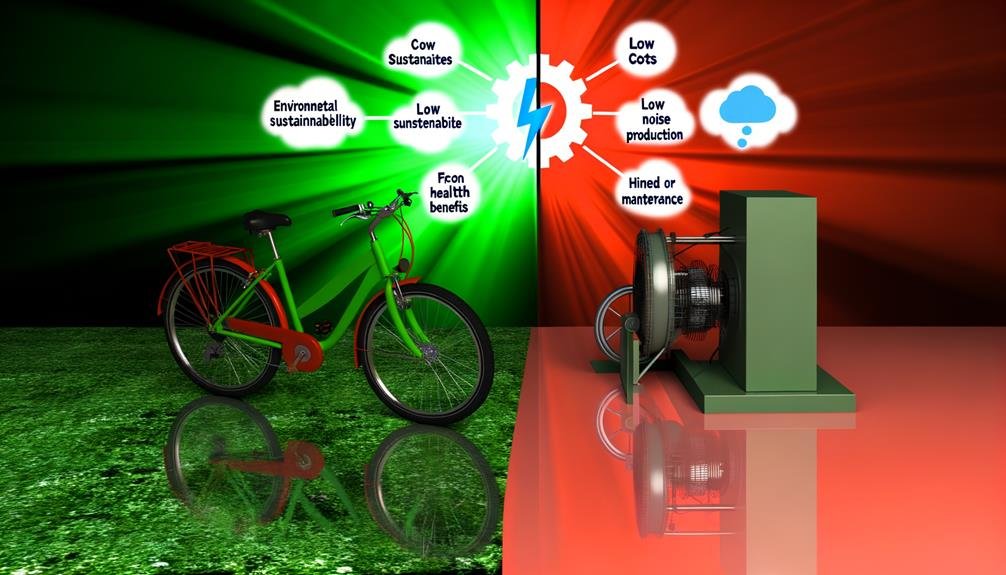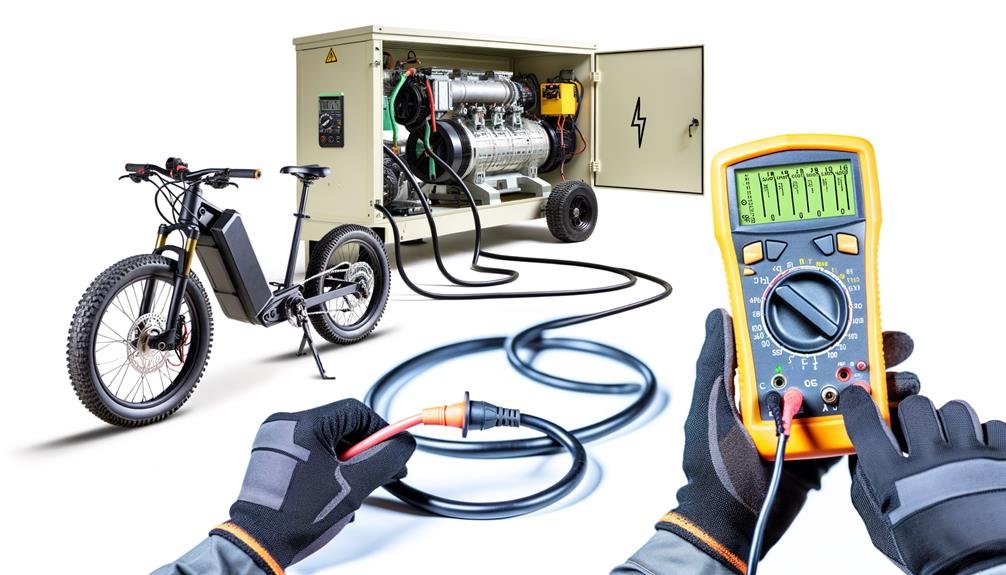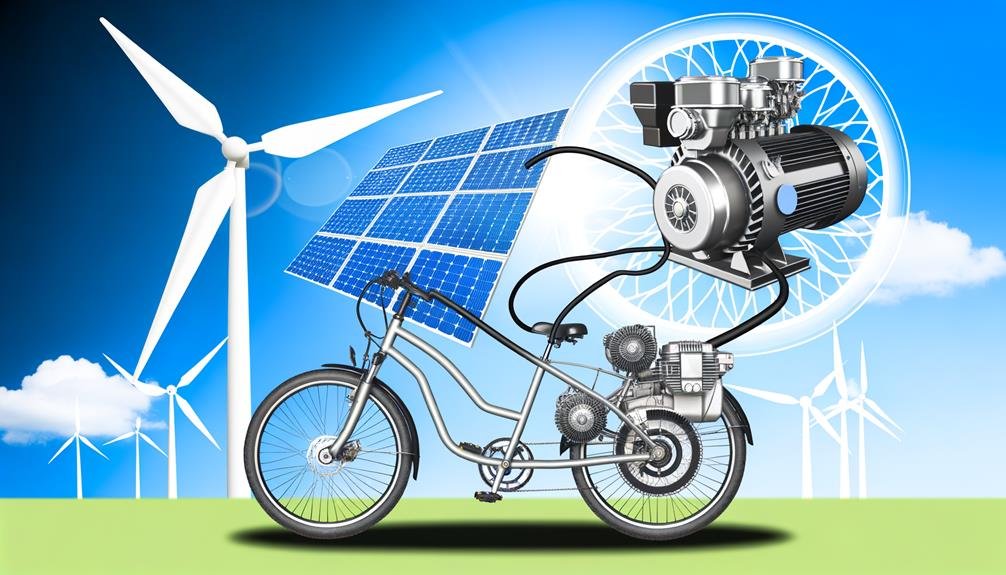Charles Miller is a veteran bike enthusiast with over 12 years of experience dealing with bikes as a mechanic. Despite immense love and expertise for...
As we delve into the realm of sustainable transportation options, the topic of electric bikes is increasingly gaining traction. One question that often emerges in this context is the feasibility of charging an electric bike with a generator.
While the quick answer is a resounding yes, it's crucial to understand that the efficiency and effectiveness of this method can be influenced by a range of factors. Key among these are the compatibility between the generator and the e-bike, the power output of the generator, and the charging requirements of the e-bike battery.
Thus, while the proposition seems straightforward, a detailed exploration of these factors could yield fascinating insights into leveraging generator power for e-bikes.
- Key Takeaways
- Understanding Generator and E-Bike Basics
- Types of Generators for E-Bike Charging
- Guide to Charging E-Bike With Generator
- Pros and Cons of Generator Charging
- Safety Measures in Generator Usage
- Protecting Your E-Bike Battery
- E-Bike and Generator Compatibility
- Power Output Checking Process
- Monitoring the Charging Procedure
- Alternative Charging Options for E-Bike
- Frequently Asked Questions
- Conclusion
Key Takeaways
- The compatibility between the generator's power output and the e-bike's charging requirements is crucial.
- Safety considerations, such as avoiding overheating and fire hazards, are important when using generators for e-bike charging.
- Proper ventilation and prevention of carbon monoxide buildup are essential for generator safety.
- It is necessary to select an appropriate generator based on power output, compatibility, and portability for charging e-bikes.
Understanding Generator and E-Bike Basics
Grasping the fundamental principles and compatibility aspects between the generator's power output and the e-bike's charging requirements is a crucial first step in utilizing a generator for e-bike charging. An understanding of generator and e-bike basics is essential to ensure effective and safe charging.
Generators, offering portable and reliable power sources, come in different types, including portable, solar, and bicycle dynamo. Each type has unique power output capabilities and requires careful consideration when pairing with e-bike batteries. Understanding the e-bike's charging requirements, specifically the voltage and current demands, is equally important. The generator's power output must align with these requirements to ensure efficient charging and avoid potential damage to the e-bike batteries.
Safety considerations also play a critical role when using a generator to charge an electric bike. Overloading a generator can result in overheating and potential fire hazards. Similarly, underloading can lead to insufficient charge, limiting the e-bike's performance and range.
Types of Generators for E-Bike Charging
Diving into the diverse pool of generators available for e-bike charging, we find options such as portable, solar, bicycle dynamo, inverter, and hybrid approach generators, each offering unique capabilities and advantages. These types of generators for e-bike charging provide the flexibility to charge an e-bike in various scenarios, ensuring riders are never left stranded due to a depleted battery.
Portable generators offer mobility and convenience, suitable for trips and outdoor adventures. In contrast, solar generators provide a green solution, harnessing renewable energy to charge an e-bike. Bicycle dynamo generators are a self-sustaining choice, utilizing the bike's own kinetic energy.
Inverter generators supply clean and stable power, ideal for sensitive electronics. On the other hand, hybrid approach generators deliver reliable power for peak load handling.
| Generator Type | Advantage | Suitable For |
|---|---|---|
| Portable | Mobility and convenience | Trips and outdoor adventures |
| Solar | Green, renewable energy | Environmentally conscious riders |
| Bicycle Dynamo | Self-sustaining, kinetic energy use | Everyday use |
| Inverter | Clean, stable power | Sensitive electronics |
| Hybrid Approach | Reliable, peak load handling | Heavy-duty use |
Guide to Charging E-Bike With Generator

Selecting an appropriate generator for an e-bike is a crucial first step, involving an analysis of power output, compatibility, and portability.
The actual process of charging with a generator requires an understanding of connection techniques and continuous monitoring to avoid overcharging.
Furthermore, adhering to safety precautions, such as using a surge protector and keeping the generator dry, is paramount to prevent accidents and enhance the longevity of both the e-bike and the generator.
Generator Selection for E-Bikes
In the realm of e-bike charging, choosing the right generator is a nuanced process that requires a deep understanding of the compatibility between the generator's power output and the charging requirements of the e-bike's battery. Generator selection for e-bikes becomes critical, as generators provide the necessary power to charge your e-bike when on the go.
- Type of Generator: Portable fuel generators, solar generators, and bicycle dynamo generators are options.
- Power Output: Ensure the generator's power output corresponds with the e-bike battery's charging needs.
- Compatibility: The charger should securely connect to the generator.
- Safety Measures: Follow manufacturer instructions, use voltage regulators, and ensure proper ventilation to prevent carbon monoxide buildup.
Understanding these factors allows you to effectively charge an electric bike with a generator.
Charging Process Explained
Having explored the critical aspects of generator selection for e-bikes, we now turn our attention to the specific process involved in charging an e-bike with a generator.
The charging process commences by connecting the e-bike charger to the generator's power outlets. The generator provides the necessary electrical energy, converting it from mechanical energy, to charge the e-bike's battery with a generator.
It's essential to monitor this process to ensure completion and prevent overcharging. Disconnect the charger once the battery is fully charged.
To ensure safety, proper ventilation for the generator is necessary, as is the use of voltage regulators to safeguard the battery.
Thus, one can charge an electric bike with a generator effectively and safely.
Safety Precautions to Consider
While charging an e-bike with a generator can be quite efficient, certain safety precautions are critical to minimize potential risks and ensure the longevity of both the generator and the e-bike battery.
- Placement of Generator: Position the generator in a well-ventilated area to avoid hazardous carbon monoxide buildup.
- Distance from Structures: Keep the generator away from structures or objects to prevent accidents or damage.
- Use of Voltage Regulators: Protect your e-bike's battery from overcharging and damage using voltage regulators or power conditioners.
- Weather Conditions: Charging your electric bike in rainy or wet conditions can lead to electrical hazards, so avoid such circumstances.
Regular maintenance of the generator is also crucial for safe and efficient operation.
Awareness and application of these safety precautions can significantly enhance your e-bike charging experience.
Pros and Cons of Generator Charging

Examining the pros and cons of charging an electric bike with a generator reveals a balance between benefits such as portability, versatility, and independence, and challenges including weight, noise, potential damage, and cost.
In terms of advantages, generator charging provides a portable, versatile power source that enables users to charge an electric bike with a generator on lengthy journeys or during outdoor adventures. This method of charging offers independence from traditional power sources and the flexibility to charge wherever and whenever needed.
However, the weight of the generator could present a challenge. While there are lightweight generators available, their limited availability could be a drawback. Furthermore, the noise and emissions produced during generator charging can be a nuisance. There is also the risk of overcharging the electric bike or providing unclean electricity, which could potentially damage the bike's battery.
Lastly, the cost associated with purchasing and maintaining a generator is another factor to consider.
Thus, while generator charging opens up possibilities for the electric bike user, it also comes with its own set of challenges that need to be carefully evaluated.
Safety Measures in Generator Usage
In considering the challenges associated with generator charging for electric bikes, it is imperative to focus on the crucial safety measures that need to be observed during generator usage. The generator, being a powerful device, also carries potential risks. Thus, while it provides a unique solution for charging your electric bike, caution must not be thrown into the wind.
This discussion will highlight four key safety measures in generator usage:
- Firstly, always place the generator in a well-ventilated area. This helps to prevent the dangerous buildup of carbon monoxide, a silent yet lethal gas.
- Secondly, maintain a safe distance between the generator and any structures or objects. This will minimize fire risks and allow for efficient operation.
- Thirdly, the use of voltage regulators or power conditioners is recommended. This will protect the battery of your electric bike during the charge and extend its lifespan.
- Lastly, avoid charging your electric bike with the generator in wet or rainy conditions. This is to prevent electrical damages or even electrocution.
Protecting Your E-Bike Battery

Ensuring the longevity and optimal performance of your e-bike battery necessitates a careful approach to its charging process, particularly when using a generator as the power source. Regular monitoring of the charging process is essential to prevent overcharging or insufficient charging, which can degrade the battery's performance over time.
Voltage regulators or power conditioners can help in protecting your e-bike battery by ensuring it receives stable and clean power. Using these devices can also help you spare battery life and prolong the overall lifespan of your e-bike's power source.
Incorporating safe practices, such as avoiding charging your e-bike battery with a generator in wet or rainy conditions, is crucial to prevent potential damage from exposure to moisture. It's also advisable to follow the manufacturer's instructions for generator usage to ensure safety and efficiency.
| Considerations | Implementation | Benefit |
|---|---|---|
| Regular Monitoring | Checking the battery level during charging | Prevents overcharging or undercharging |
| Voltage Regulators | Ensures stable and clean power | Protects and prolongs battery life |
| Avoid Wet Conditions | Charging in dry conditions | Prevents potential battery damage |
| Proper Generator Usage | Follow manufacturer's instructions | Ensures safety and efficiency |
| Alternatives | Use power banks, regenerative braking, or public charging stations | Ensures continuous power availability |
E-Bike and Generator Compatibility
To ensure optimal charging of an e-bike with a generator, one must first assess the compatibility between the power output of the generator and the charging requirements of the e-bike battery. This involves a technical understanding of power requirements and the generator's energy conversion efficiency.
Furthermore, safety precautions are necessary to prevent issues such as overcharging, overheating, and potential damage to the e-bike battery.
Understanding Power Requirements
Comprehending the power requirements of your e-bike and establishing compatibility with a generator is a critical step in leveraging this alternative charging method.
- Power Output: Understanding power requirements involves matching the generator's power output with the e-bike battery's charging needs.
- Outlets Compatibility: Compatibility is key. Make sure the generator's outlets fit the e-bike's charger.
- Types of Generators: Different generators such as portable, solar, and bicycle dynamo offer diverse options to charge an electric bike. Choose what suits your needs.
- Charging Process: To charge an e-bike with a generator, connect the charger to the generator's outlets, monitor the charging, and follow safety precautions meticulously.
Understanding these power requirements ensures an efficient and safe charging process.
Safety Precautions Needed
Having established an understanding of the power requirements for charging an electric bike with a generator, it is imperative to now focus on the necessary safety precautions to uphold when ensuring e-bike and generator compatibility.
Foremost, check the compatibility between the generator's power output and the e-bike's charging needs.
The generator should be situated in a well-ventilated area, avoiding carbon monoxide buildup.
It's also advisable to use voltage regulators or power conditioners to shield the e-bike battery from overcharging.
Always adhere to the manufacturer's instructions for both the generator and e-bike charger to guarantee safe, efficient charging.
Lastly, ensure the generator is kept distant from flammable materials and never operated indoors or in confined spaces.
Power Output Checking Process

In the power output checking process, one must first ascertain the compatibility and power output of the generator with the e-bike's charging requirements. It's crucial to ensure the generator can deliver the necessary power output to charge the electric bike adequately without causing any electrical issues. This step is pivotal in maintaining the e-bike's efficiency and longevity.
To perform this process successfully, follow these steps:
- Confirm the power output of the generator. It should match or exceed the e-bike's charging requirements. If the generator's power output is inadequate, the e-bike may charge slowly, or not at all.
- Securely connect the e-bike charger to the generator. Ensure it's a firm connection to prevent any power interruptions during the charge.
- Start the generator following the manufacturer's instructions, and monitor it to ensure it's running smoothly. Any irregularities could affect the charging process.
- Finally, monitor the electric bike's battery level indicator during charging. It should align with the expected charging duration. If it doesn't, there might be an issue with the generator's power output.
Monitoring the Charging Procedure
After confirming the power output and securing the generator's connection to the electric bike, it becomes essential to vigilantly monitor the charging procedure to ensure optimum charging and battery health.
The charging procedure requires careful attention to maintain the longevity of your e-bike's battery. Routine checks on the power output are necessary to avoid undercharging. In addition, the charging process should be monitored closely to prevent overcharging, which can adversely affect battery life.
Below is an overview of the suggested checks and procedures:
```
| Procedure | Importance |
|---|---|
| Check Power Output | To avoid undercharging |
| Monitor Charging Process | To prevent overcharging |
| Disconnect and Turn Off | To limit unnecessary power consumption |
| Secure the Connection | For a functional and efficient charging |
| Regular Maintenance of Generator | To ensure reliable charging |
```
These measures are crucial to ensure the generator is providing a secure and efficient charge to your e-bike. The charging process is as vital as the ride itself, and following these steps will help preserve the longevity and performance of your electric bike.
Alternative Charging Options for E-Bike

Exploring alternative charging options for electric bikes can significantly enhance their utility, offering increased flexibility for long-distance travel, outdoor adventures, and off-grid living. It is crucial to identify efficient and reliable methods to charge an electric bike, and a generator often provides a viable solution.
Consider these four alternative charging options for your e-bike:
- Portable Generator: Compact and lightweight, these generators are ideal for travel. They can easily charge an electric bike, making them perfect for long journeys.
- Solar Generator: An environmentally friendly option, solar generators utilize the sun's energy to charge an e-bike. However, their effectiveness is dependent on weather conditions.
- Bicycle Dynamo Generator: This innovative solution uses the kinetic energy produced while cycling to generate power, essentially charging your e-bike as you ride.
- Voltage Regulator: Protects the battery by ensuring a constant and safe charge from the generator.
From an analytical perspective, each of these options presents unique advantages and challenges. Careful consideration of factors such as portability, weather dependency, and safety will guide e-bike users to select the most suitable alternative charging option.
Frequently Asked Questions
What Generator Can Charge an Ev?
You can charge an electric vehicle (EV) with generators like portable or solar ones. Generator efficiency, charging speed, and fuel consumption vary, so choose based on your EV's power requirements and the generator's output capability.
How Can I Charge My Electric Bike at Home?
Through diligent bike maintenance and proper charging techniques, you can charge your electric bike at home using standard outlets. This method extends battery lifespan and allows for convenient, consistent power supply for your e-bike.
Can You Charge an Ebike Battery With a Solar Generator?
Yes, charging an e-bike battery with a solar generator is feasible. Solar generators offer portable solutions, enhancing battery lifetime. They're environmentally friendly, maximizing solar efficiency, and fostering a sense of belonging to eco-conscious communities.
How Much Voltage Is Needed to Charge an Electric Bike?
To ensure battery lifespan and voltage safety, an electric bike typically requires a voltage regulation of around 42V for charging. However, high voltage charging can lead to overheating, thus affecting the battery's performance and longevity.
Conclusion
In conclusion, utilizing a generator to charge an electric bike presents a viable solution for long-distance travels and outdoor expeditions.
However, the imperative lies in ensuring the compatibility and correct power output between the two entities.
With careful monitoring of the charging process, adherence to safety protocols, and exploration of alternative charging options, the symbiosis of generators and e-bikes could revolutionize the realm of eco-friendly transportation, creating a synergy between technology and nature.

Charles Miller is a veteran bike enthusiast with over 12 years of experience dealing with bikes as a mechanic. Despite immense love and expertise for his Tacoma, he rides his Trek Ebike more. Anytime you meet him, you’ll either hear him talking about Bikes, or writing about all things bikes and cars on this blog.
More Posts


